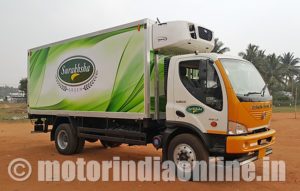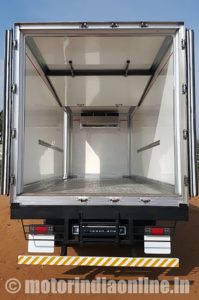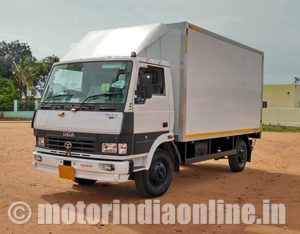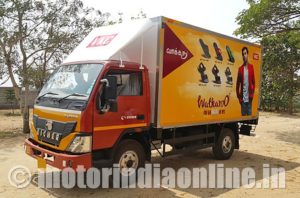The container business in India has been galloping along in recent times. Containers of all sizes moving along majestically has become a common sight on the Indian highways. One company that has silently made a distinct mark for itself in this sector has been Surakhsha Transport Systems (India) Pvt. Ltd. The Coimbatore-based manufacturer of containers has always been known for its thrust on quality and innovation. Its latest innovation – the ‘Surakhsha Green’ container – is a testimonial to the company’s consistent R&D focus and could well turn out to be a game-changer that could catapult the company’s reputation at the global level.
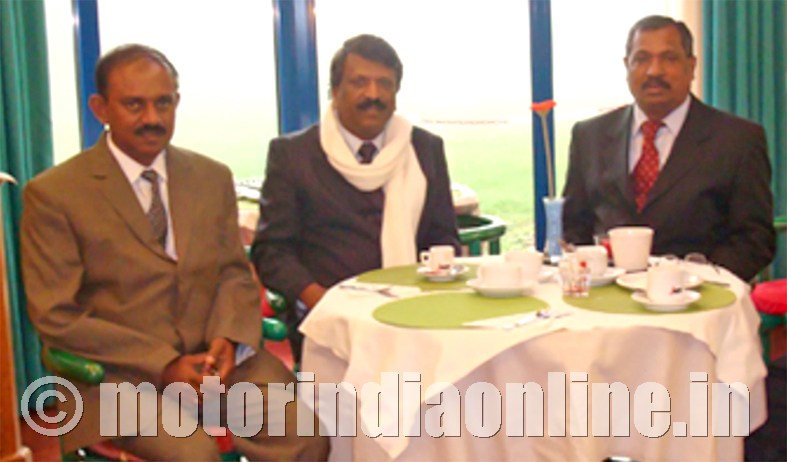
In an exclusive interview to MOTORINDIA, Mr. V.P. Vargheese, Managing Director of the company, gave detailed insights into Surakhsha’s history, the development of ‘Surakhsha Green’ containers, their sustainability quotient, their market potential and the top management’s vision and plans for the future.
Surakhsha Transport Systems was established in October 2000. “We started the company with the primary objective of manufacturing containers for the road transport sector,” said Mr. Vargheese, beginning the interaction. “Although we started the company in 2000, we began full-fledged manufacturing in January 2003, prior to that we only had skeletal operations.”
The key focus area of the company is production of containers for transport of perishable commodities, which includes containers which are insulated as well as those which are refrigerated. The other members of the top management include the Directors, Mr. V.D. Sasindran Nair and Mr. Babu D.
The wide range of products manufactured by the company include, mild steel containers aluminum / steel composite refrigerated containers, GRP sandwich panel containers, PUF-insulated containers, dry cargo steel containers and stainless steel road milk tankers.
“While we manufacture different types of super structures on truck chassis, our emphasis is on containers for the cold chain sector. This sector is all set for a boom. The Government also has been taking steps to encourage this particular sector,” said Mr. Vargheese.
He also felt that overall, with respect to the commercial vehicles industry, things are looking up. “The GST is now in place. It provides a level playing field. We are free from tax cascading effects. The country’s road infrastructure is improving by the day. Importantly, there is a lot more awareness with respect to the effects of the loads being carried by trucks. Overloading is coming down. There are also hefty fines these days on overloading. So, people will be constrained to transport within the approved limits. This is where the container business is going to grow rapidly. People want to move their commodities in a safe manner. They don’t want thefts taking place or damages to the materials they are transporting,” Mr. Vargheese observed.
Changing trends
Going into details about the changing trends in the container business, Mr. Vargheese felt that these days fleet owners are concerned about aspects such as corrosion and maintenance of containers, which could turn out to be a costly affair in the long run. The increasing emphasis on sustainability in almost every sector is seen having its impact on the transport sector too.
“So, what is the solution then? Let’s take a look at the materials that are being used for container manufacturing. We have mild steel, aluminium, GRP, etc. Now, aluminium offers you a plain surface outside, it has got high resale value and is also easier to maintain. But it is also expensive. Similarly, each one of these materials has its own pros and cons. So, the question arises as to what is the ideal container product for the discerning customer?”, Mr. Vargheese remarked.
Surakhsha Transport Systems has done a detailed study and come up with a list of 23 parameters. Based on these parameters, the company has developed its innovative green container which it is offering under the sub-brand ‘Surakhsha Green’. So, what exactly is this ‘Green Container’ all about? “One of the materials widely used in the construction industry is UPVC, i.e., unplasticized PVC. What we thought was why not use UPVC for making containers, basically double-walled honeycomb panels,” Mr. Vargheese said pointing out to the development of the Green Container.
According to him, the Green Container offers a host of advantages. First and foremost is the cost factor. Since UPVC is half the density of aluminium, it is not an expensive a proposition to make a container out of it.
He added: “In fact it would cost only about 50-60 per cent of the cost of an aluminium container. Another advantage is that the container will be plain both inside and outside. Our containers feature an interlocking panel system, which means there would be lines showing up on the surface. Now, what we have done is to develop our own vacuum process and laminate the surface. The result is a smooth surface, both inside and outside the container.”
The smooth plain surface also adds to the aesthetic value of the container, apart from helping in another way, i.e., mobile branding. Throwing light on this emerging trend, Mr. Vargheese stated: “Using the external surface of containers as mobile hoardings for branding purposes is picking up in a big way in India. Our Green Containers are in fact tailor made for such mobile branding because of the superior finish of the external surface.”
The Green Container is also significantly lighter, while at the same time being as tough as its other material counterparts. What imparts this feature to the containers is the optimal blend of seven materials that go into manufacture of these containers. The materials used include, UPVC, Aluminium Profiles, stainless steel, insulation material, plywood, mild steel and GRP. One of the biggest benefits of this blend is the fact that two third of the materials are reusable, adding to the sustainability quotient of the Green Containers.
Another major advantage with the Green Containers is the fact that no portion of the container is prone to corrosion. Moreover, these containers require only minimal maintenance. “You also won’t see any bolts or rivets protruding out of these containers. There are provisions made for cranes to lift the containers, but they have been designed in a well disguised manner, adding to the aesthetic factor,” explained Mr. Vargheese.
The Green Containers, since they feature a modular design, can also be moved as a kit. This feature, while allowing for local assembly, also helps reduce transport costs too.
R&D focus
Surakhsha Green is a result of three years of intense R&D. “The product is a result of 3 years of hard work, for which we also had to make substantial investments. In fact, we started work on this project in 2014. Initially we developed an aluminium concept container. Then gradually we developed this product,” he said.
According to Mr. Vargheese, it has not all been a smooth sailing. “We have been getting a lot of feedback from end-users and making tweaks in the design. Improvement is a constant process for us. As we all know change is always resisted. When we came up with the concept people questioned the logic saying there were already good quality steel containers available, so why one made of a different material? So, there some early takers and also a good number of resistors. This is the case with any product, I suppose. We have been getting constant feedback from the 100-odd customers to whom we have supplied this product and have been constantly improving the product.”
Key strengths
Listing down the key strengths of the company which have helped the company achieve newer heights, Mr. Vargheese pointed out: “Quality has always been our forte. Plus, the fact that the performance of our containers speaks for itself. They are our best word of mouth advertisement. Our containers score particularly in the area of thermal performance. This is one area where we feel we are the best in the country, and it is not surprising that Surakhsha is such a popular brand in the cold storage sector. Finally, there is also the price factor.”
The development of the Green Container is a humble contribution of the company towards the Prime Minister’s ‘Make in India’ program. He disclosed: “Not only have we developed a new product, we have actually created a new market segment which has immense growth potential not only in India but throughout the world. Inspired by the ‘Make in India’ program, with the proper back-up and support we can make this product a huge global success.”
Green Containers – Various Applications
On the application of Green Containers, the company visualizes that the following three segments will be prominent:
- Green Ambient – These are Containers with light insulation (25mm) so that the interior will not get heated up in the tropical ambient. Further the internal temperature can be brought down below the normal ambient by a few degrees by adding a small reefer unit. Green Ambient containers will be the obvious choice for transport of fruits & vegetables, where the freshness will be retained longer, and also for similar food and heat sensitive products.
- Green Chilled – For transport commodities at +0 deg and above
- Green Frozen – For transport commodities at temperature as low as -25 Deg C
Clear-cut roadmap charted out
The company which has 300 people working for it and manufacturing approximately 100 containers monthly (all variants together) has a clear-cut road map charted out for its future growth. Elaborating on the same, Mr. Vargheese quipped: “By 2020 we would like to double our manufacturing capacity to 200 containers. Plus, we want to take this product globally. We may add a few more assembling units in the near future too.”
The company also has tie-ups with leading OEMs, including, Ashok Leyland, Tata and Eicher, wherein it builds containers on their chassis and the OEMs in turn sell the fully-built units.
“More and more fully-built trucks are going to hit the road. The levels of quality awareness are going up. While there was a bit of lull during the demonetization period, the container segment is now all set for a period of rapid growth, particularly refrigerated containers. The Government is encouraging this sector. While refrigerated containers attract a GST of 18%, the other types attract 28%. There is directly a 10% difference. With the port, logistics and road infrastructure improving and with an increasing number of industries seeking refrigerated transport, the future looks very bright indeed,” said Mr. Vargheese signing off on a positive note.
By M.K. Prabhakar
